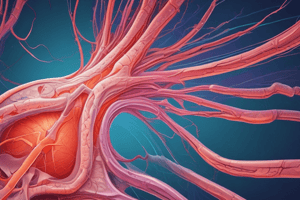Podcast
Questions and Answers
Which of these locations is NOT a site where loose connective tissue is found?
Which of these locations is NOT a site where loose connective tissue is found?
- Periosteum of the bone (correct)
- Submucosa of the digestive tract
- Leptomeninges
- Papillary layer of the dermis
Which type of connective tissue provides tensile strength in all directions?
Which type of connective tissue provides tensile strength in all directions?
- Dense irregular connective tissue (correct)
- Loose connective tissue
- Dense regular connective tissue
- Elastic connective tissue
What is the primary function of the endotenon in tendons?
What is the primary function of the endotenon in tendons?
- To connect tendons to bones
- To form the outer layer of tendons
- To provide elasticity to tendons
- To surround and support primary fascicles of collagen fibers (correct)
What is the primary difference in the structure of tendons and ligaments?
What is the primary difference in the structure of tendons and ligaments?
Which type of connective tissue is responsible for providing nourishment to epithelial tissues?
Which type of connective tissue is responsible for providing nourishment to epithelial tissues?
Besides fibroblasts, what other cells are commonly found in loose connective tissue?
Besides fibroblasts, what other cells are commonly found in loose connective tissue?
What is the primary component of the ground substance in dense connective tissue?
What is the primary component of the ground substance in dense connective tissue?
Which of these is NOT a typical characteristic of dense connective tissue?
Which of these is NOT a typical characteristic of dense connective tissue?
Flashcards
Loose Connective Tissue
Loose Connective Tissue
Most common type of connective tissue, with disorganized microscopic structure.
Composition of Loose Connective Tissue
Composition of Loose Connective Tissue
Equal proportions of cells, fibers, and ground substance, with a moderately viscous ground substance.
Function of Loose Connective Tissue
Function of Loose Connective Tissue
Provides nourishment to epithelial tissues and aids in immune surveillance.
Dense Connective Tissue
Dense Connective Tissue
Signup and view all the flashcards
Dense Irregular Connective Tissue
Dense Irregular Connective Tissue
Signup and view all the flashcards
Examples of Dense Irregular Connective Tissue
Examples of Dense Irregular Connective Tissue
Signup and view all the flashcards
Dense Regular Connective Tissue
Dense Regular Connective Tissue
Signup and view all the flashcards
Structure of Tendons
Structure of Tendons
Signup and view all the flashcards
Study Notes
Loose Connective Tissue
- Predominant tissue type
- Microscopic appearance is relatively disorganized
- Cells, fibers, and ground substance are present in roughly equal proportions
- Ground substance is moderately viscous
- Contains all cell types (fixed and migrating)
- Contains collagen, reticular, and elastic fibers with a reticular arrangement
- Found around blood vessels, lymphatics, nerves
- Supports epithelium, mesothelium, and parts of the nervous system
- Part of the leptomeninges (pia mater and arachnoid)
- Part of the digestive system's submucosa
- Part of the papillary dermis and the corium
- Fills spaces between organs
- Richly vascularized, providing nutrition to epithelium
- Contains immune cells (lymphocytes, plasma cells, and histiocytes)
- Plays a role in immune surveillance against foreign substances
Dense Irregular Connective Tissue
- Predominantly collagen fibers (primarily type I)
- Fewer cells compared to loose connective tissue (mainly fibroblasts)
- Collagen fibers are arranged in bundles with varying thickness and direction
- Provides strength in multiple directions
- Found in the deep dermis, mucous membranes of the urinary tract, and most organ capsules
Dense Regular Connective Tissue
- Collagen fibers are oriented parallel to one another following a predetermined pattern set by mechanical forces
- Less vascularized, relying mainly on diffusion for nutrition (particularly characteristic of dense regular connective tissue)
- Found in areas requiring high tensile strength
- Examples include tendons, ligaments, and aponeuroses. Tendons connect muscles to bones, while ligaments connect bones to bones. Aponeuroses are sheet-like structures connecting muscles to other tissues.
- Tendons and ligaments are mainly composed of densely packed collagen fibers arranged in parallel bundles. The fibers are surrounded by a ground substance-rich layer that contains cells (fibroblasts, or tenocytes)
- Tendons are surrounded by a fibrous sheath (epitenon), and fascicles within the tendon are further enclosed by endotenon. Ligaments are similarly enclosed by a connective tissue sheath.
- Muscle to bone connection, joint stabilization, and body support are the roles of tendons and ligaments
Studying That Suits You
Use AI to generate personalized quizzes and flashcards to suit your learning preferences.




